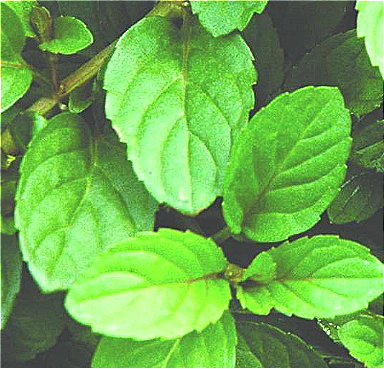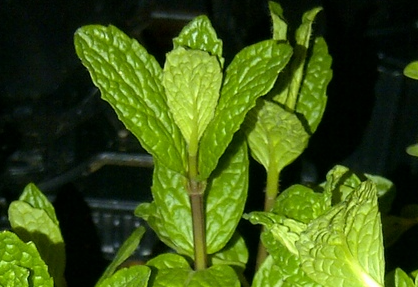Mentha piperita (peppermint) oil is a product of natural origin obtained from the peppermint seedling, Mentha piperita (L.), belonging to the botanical family Labiatae.

The name describes the structure of the molecule:
- "Mentha piperita". This is the scientific name for the plant commonly known as peppermint.
- "Oil". This term indicates that the product is an essential oil extracted from the plant.
Description of raw materials used in production and their functions.
- Mentha piperita plants. These are the primary source of the essential oil. The leaves and the flowers contain the highest amounts of oil.
Step-by-step summary of industrial chemical synthesis process.
- Cultivation and Harvesting. The Mentha piperita plant is grown and harvested at the right time, preferably when flowering starts.
- Drying. The plants are dried in the shade to retain volatile compounds.
- Steam Distillation. Drying is followed by steam distillation of the aerial parts of the plant. This method extracts the oil without degrading the delicate compounds within it.
- Separation. Once distilled, the peppermint oil separates from the water due to being less dense and is collected.
- Bottling and Storage. The oil is then filtered and bottled in dark containers to protect it from light. It's stored in a cool, dry place to retain its potency and freshness.
It appears as a yellowish-colored oily liquid.

What it is for and where
Medical
Mentha piperita contains some useful components for human health, phenolic acids and flavonoids: rosmarinic acid, quercetin, gallic acid, components known for their antimicrobial (1), antioxidant (2) and antifungal action (3).
This study explored the antibacterial activities of a mentha piperita extract and concluded that the polyphenol content demonstrated bacteriostatic properties and antiadhesive activity against strains of bacteria of the genus Asaia (a contaminant of industrial beverages) confirming its total antioxidant activity (4).
Another special feature of the healing properties of this mint is the improvement in the wound healings treated with topical application of essential oil (5).
Cosmetics
Fragrance. It plays a very important role in the formulation of cosmetic products as it provides the possibility of enhancing, masking or adding fragrance to the final product, increasing its marketability. It is able to create a perceptible pleasant odour, masking a bad smell. The consumer always expects to find a pleasant or distinctive scent in a cosmetic product.
Refreshing. This ingredient is included in cosmetic products to provide a refreshing or toning sensation to the skin and can also help relieve irritation or redness.
Tonic. This product is used to treat the hair when the scalp is clean or after shampooing. It stimulates hair growth, revitalises the scalp for healthy hair growth and reduces hair loss. It provides a feeling of well-being on skin and hair.
Perfuming. Unlike fragrance, which can also contain slightly less pleasant or characteristic odours, the term perfume indicates only very pleasant fragrances. Used for perfumes and aromatic raw materials.
CAS 8006-90-4 84082-70-2
EC number 282-015-4
Cosmetic safety
Restricted cosmetic ingredient as III/361 a Relevant Item in the Annexes of the European Cosmetics Regulation 1223/2009. Substance or ingredient reported: Mentha piperita oil. The presence of the substance shall be indicated in the list of ingredients referred to in Article 19(1), point (g), when its concentration exceeds: — 0,001 % in leave-on products — 0,01 % in rinse-off products.
Commercial applications
Cosmetics and Personal Care. Mentha piperita oil is used in products like toothpastes, breath fresheners, lip balms, and skin care products due to its refreshing and fragrant properties.
Health and Wellness. It's often employed as a natural remedy to alleviate issues such as indigestion, headaches, and muscle ailments. It can be taken in capsule form or applied topically.
Food Industry. Mentha piperita oil is utilized as a flavoring in foods and beverages, such as candies, chewing gums, and some drinks.
Aromatherapy. It is used for its relaxing and revitalizing properties.
References____________________________________________________________
(1) Seyedeh Maryam Sharafi, Iraj Rasooli, Parviz Owlia, Massoud Taghizadeh, and Shakiba Darvish Alipoor Astaneh Protective effects of bioactive phytochemicals from Mentha piperita with multiple health potentials Pharmacogn Mag. 2010 Jul-Sep; 6(23): 147–153. doi: 10.4103/0973-1296.66926
(2) Ravindra M.Samarth, Meenakshi Panwar, Manish Kumar, Anil Soni, Madhu Kumar, Ashok Kumar Evaluation of antioxidant and radical-scavenging activities of certain radioprotective plant extracts Food chemistry, 2008 - Elsevier
(3) Mafakheri H, Mirghazanfari SM Antifungal activity of the essential oils of some medicinal plants against human and plant fungal pathogens. . Cell Mol Biol (Noisy-le-grand). 2018 Dec 31;64(15):13-19.
(4) Antolak H, Czyżowska A, Kręgiel D. Activity of Mentha piperita L. Ethanol Extract against Acetic Acid Bacteria Asaia spp. Foods. 2018 Oct 18;7(10). pii: E171. doi: 10.3390/foods7100171.
(5) Modarresi M, Farahpour MR, Baradaran B. Topical application of Mentha piperita essential oil accelerates wound healing in infected mice model. Inflammopharmacology. 2019 Jun;27(3):531-537. doi: 10.1007/s10787-018-0510-0.
![]() mentha piperita (peppermint) oil
mentha piperita (peppermint) oil 



